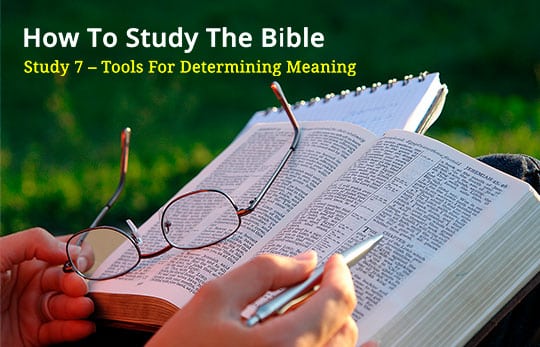
In this study, we will learn about some Bible tools that will be very helpful in understanding the meaning of Scripture. But first we will quickly review the three-letter acronym that we have been using to guide our Bible study. The acronym is SMA. The S symbolizes “What does it say?” The M represents “What does it mean?” The A stands for “How does it apply?”
In order to discover what the Bible says, a person needs to read the Scripture passage at least four times. We suggest once a day for a month when possible. The first time we read a verse, a passage, or a chapter we should try to understand the big picture using a Bible that is accurate to the original Hebrew, Aramaic, and Greek. The second time we read, we want to look for details such as who, what, when, and where, for example. If we are in the gospels, we should look at the other gospels to discover if they wrote about the event. The same is true if we are studying 1 and 2 Kings and 1 and 2 Chronicles. Then we should compare them to collect additional information. That will give us more insight into what happened. The third reading involves discovering the meaning of words and phrases.

The Canaanite Woman
In this study, we will do three things. First, we will discuss the third reading. Next, we will study what Matthew 15:21-28 says, and then discover some helpful tools for understanding the meaning of Scripture.
So, let’s begin by reading Matthew 15:21-28. The passage says,
Jesus went away from there, and withdrew into the district of Tyre and Sidon. And a Canaanite woman from that region came out and began to cry out, saying, “Have mercy on me, Lord, Son of David; my daughter is cruelly demon-possessed.” But He did not answer her a word.
And His disciples came and implored Him, saying, “Send her away, because she keeps shouting at us.” But He answered and said, “I was sent only to the lost sheep of the house of Israel.”
But she came and began to bow down before Him, saying, “Lord, help me!” And He answered and said, “It is not good to take the children’s bread and throw it to the dogs.” But she said, “Yes, Lord; but even the dogs feed on the crumbs which fall from their masters’ table.” Then Jesus said to her, “O woman, your faith is great; it shall be done for you as you wish.” And her daughter was healed at once. Matthew 15:21-28 (NASB)
The first letter in our acronym, SMA, symbolizes “What does it say?” So we need to start asking questions that help us determine what it says. When we are trying to understand what the Bible says, we should avoid asking questions such as, “Why?” and “How?” at the beginning. These questions usually require us to assume things that are not specifically mentioned in Scripture. This is important since we tend to make assumptions before we have all the information. Then we tend to cling to those assumptions.
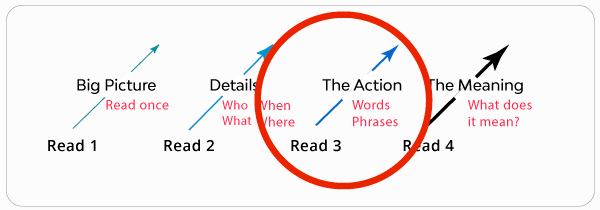
Who is Mentioned in the Passage?
So, the first question we want to ask is, “Who is mentioned in the passage?” The answer is Jesus, a Canaanite woman, the woman’s daughter, a demon, the disciples, and the “lost sheep of the house of Israel.” Six different individuals or groups of people are mentioned. Now we have more questions. Who is a Canaanite? To find the answer we could search the Old Testament for every occurrence of “Canaanite” and discover something about this group of people. Also, if we do not understand demons and demon possession, then we could use a Bible tool to give us some information about demons and the Canaanites. We will also want to understand “lost sheep of the house of Israel.” Another Bible tool can help. So, we are now collecting more questions. You might want to keep a list of your questions.
What Happened?
Another important question is, “What happened?” This gives us the big picture. We are told that Jesus went to the region of Tyre and Sidon. There a Canaanite woman found Him and asked Jesus for mercy, explaining that her daughter was demon possessed. The disciples wanted Jesus to send her away. Jesus and the woman have a discussion. Eventually, Jesus promised to heal her daughter and He did. That is the big picture.
When and Where?
Our next two questions are, “When? and Where?” These two questions tell us that this event occurred when Jesus entered the district of Tyre and Sidon. But where is Tyre and Sidon located compared to Galilee or Judea? One wonders how did the Canaanite woman know Jesus had arrived? How long were Jesus and the disciples in the region? We are not given any information that will help us answer these questions.
Who Said What?
There is a great amount of discussion in this passage. So, we should ask questions that help us understand some of the spoken words in the passage. Verbs are often very important. They describe action and give us a sense that is often missing in the English. The Greek verb tenses are very unique. Verbs such as “cry out” and “saying” in verse 22 in the NASB could be important. In the ESV those two words are reduced to the single word “crying.” In verse 23, we find the verb “implored” in the NASB. In the ESV, the word is “begged.” The words “saying” and “help” in verse 25 may be important to us. Nouns are important too! For example, the word “dogs” in verses 26 and 27 should be explored. It is possible that “at once” in the NASB and “instantly” in the ESV in verse 28 are important. Now we need some Bible tools to help us further understand what the passage says.
What Bible Tools Do We Need?
Bible tools will help us understand the questions we have collected. Therefore, I want to recommend some great tools in various categories. I am not suggesting that you buy all of these tools, but try to obtain at least one in each category. I would suggest that you buy used books to help minimize your cost. I also want to add that we need to be cautious about buying the newer books because some tend to be more liberal than those published in the past. The shift to the left is occurring rapidly. So, if you do buy a recently published volume, ask for a recommendation from someone you trust.
There is a wonderful list of recommended books that was published by Masters Seminary, 850 Books for Biblical Expositors. The list contains great books from men of different denominations. But every book is of high quality. Another excellent resource is Commentaries for Biblical Expositors by Dr. James Rosscup. The books recommended in this study are intended for someone who is beginning a biblical library.
Bible Atlas
The first question we want to answer is, “Where are Tyre and Sidon located?” We will answer the questions about the people later. In order to locate these cities, we need a good set of Bible maps. Two excellent Bible atlases are The New Moody Atlas of the Bible by Barry Beitzel and Satellite Bible Atlas by William Schlegel. The Satellite Bible Atlas is unique since it provides digital maps. It was published by BiblePlaces.com. This book also shows the path that Jesus and the disciples took from Galilee north into the district of Tyre and Sidon. This helps us understand that Jesus and the disciples are in Gentile territory, specifically in Canaanite territory. Why did Jesus and the disciples go to Gentile territory?
Bible Dictionary
Another category of Bible tools are Bible dictionaries. It is important to own at least two of these books since the topics covered will vary from book to book. These books can provide excellent information on a wide range of important biblical topics. For example, a Bible dictionary can help us understand who the Canaanites were. Two outstanding Bible dictionaries are the New Unger’s Bible Dictionary by Merril Unger, and the New Bible Dictionary by Donald Guthrie, if you can find this one. The New Unger’s Bible Dictionary is the newest. It states this about Canaanites,
The Canaanites were the inhabitants of Canaan, the more ancient name of Palestine. The Heb. form of Canaan apparently was taken from Hurrian, signifying “belonging to the land of red-purple.’’ . . . By the time of the conquest the term Canaan signified the territory later called Palestine.[1]
We will discover later in Mark 7:24-30 that this Canaanite woman was also a Syrophoenician. Unger’s gives information about Syrophoenicians.
Bible Concordance
Bible concordances can help us locate a verse, if we can remember some of the words of the verse. Then we find a few of the words from the verse in the concordance and search for the Bible reference. A concordance also helps us find the original Hebrew, Aramaic, or Greek word for the English words in our Bible. They also provide a basic meaning of the Hebrew, Aramaic, or Greek word. There are three highly recommended concordances. Maybe the most well-known is New Strong’s Exhaustive Concordance by James Strong. There are several versions of Strong’s work available, including one for the NASB. Another common one is Young’s Analytical Concordance to the Bible by Robert Young. A third one is Cruden’s Complete Concordance by Alexander Cruden.
Now we can start answering the question about the meaning of words, such as “dogs” in verses 26 and 27, if we can look up “dogs” in Strong’s Concordance. First, we find “dogs” and then look for Matthew 15:26 and Matthew 15:27. The Strong’s number is 2952. Then in the back of the concordance, we can find the basic definition of this Greek word. Strong’s gives the definition of “little dog.” If we return to the listing for “dog,” we find that Matthew 7:6 gives a Strong’s number of 2965. The basic definition is simply “dog.”
Young’s Analytical Concordance to the Bible lists “dog” by the different Greek words that are translated as dog. It indicates that the Greek for “dog” in Matthew 15:26 and Matthew 15:27 is kunarion. It means “little dog.”
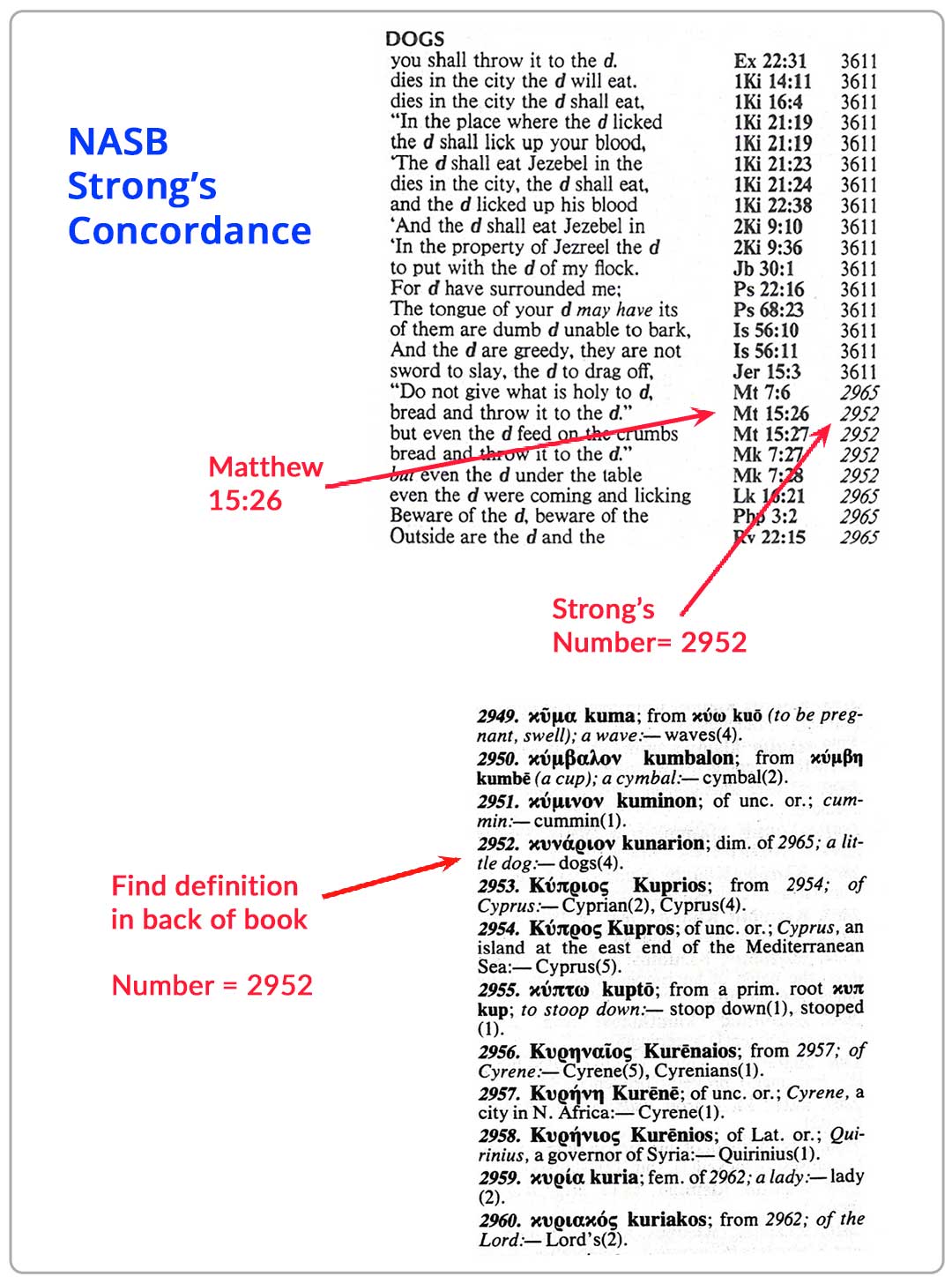
Bible Software
There are many Bible software options available. Three options to consider are Olive Tree Bible App, Accordance Bible Software, and perhaps the best ones on the market are the various versions of Logos Bible Software. Above is a screenshot of Matthew 15:26. The Bible software displays the Greek text below in the NASB, in this example. The Greek word is kunarion. By hovering the cursor over Louw and Nida’s word definition, we learn that kunarion is better translated as a “house dog,” since little dogs do exist in the wild.
We can also discover that the definition of the Greek word that is translated as “cry out” in verse 22 is better translated as “shout.” We are also told that it is an imperfect verb, telling us that she was repeatedly shouting at Jesus. The imperfect tense refers to repeated action. What does that reveal the Canaanite woman is doing to Jesus?
The word “implored” in verse 23 means “to ask.” But since the verb is also an imperfect, the word reveals that she was repeatedly asking. She was begging Jesus. Therefore, the ESV translates the words as “begging.” What does that reveal about her belief that Jesus could heal her daughter? Does this help us understand the disciples’ attitude?
The Greek for “help” in verse 25 is in the imperative tense. That means the woman is demanding help. She was being very forceful.
Finally, the word “instantly” in the ESV in verse 28 is a noun and could be translated as “from that hour.” These examples reveal the richness of the Greek and the verb tenses.
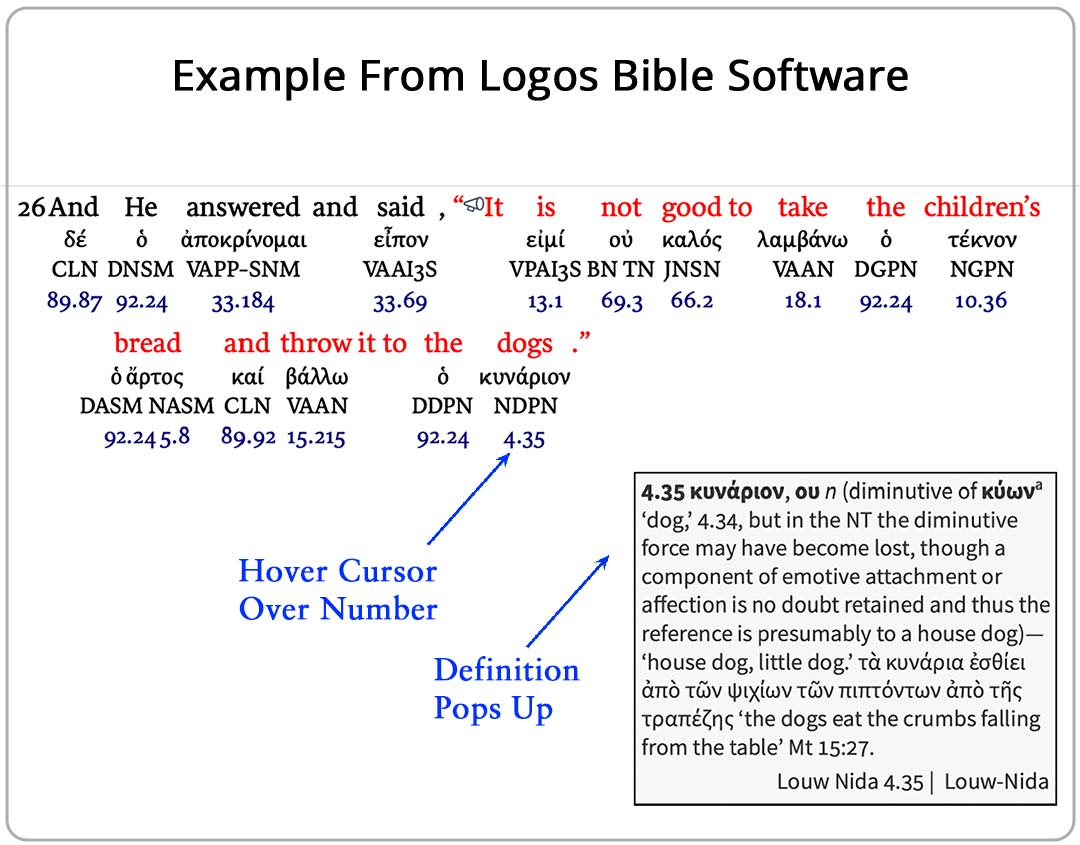
What Does It Mean?
At this point, we have discovered what the passage says, and we are ready to start understanding the meaning of the passage. This takes us to the fourth reading. So, we should read it again. But for the sake of the length of this article, we leave the reading to the reader.
We are now in the trenches of the most difficult part of Bible study. In order to understand the meaning of the passage, we need to read the context, explore cross references, and read the opinion of others. As we explore the meaning, we need to figuratively “step back” repeatedly and reevaluate our interpretation of the passage. Remember our goal is to discover the truth. We must be careful to not seek support for our initial understanding or interpretation.
Cross References & Topical Helps
The next step is to use a book like The Treasury of Scripture Knowledge by R. A. Torrey, and Nave’s Topical Bible by Orville Nave. The Treasury of Scripture Knowledge provides a list of suggested cross-references that we should visit. If we visit Matthew 15:24, we discover one of the cross-references is Matthew 10:5, 6. If we read the context, we have another answer to another question, “What is the meaning of the lost sheep of the house of Israel?” This verse reads,
These twelve Jesus sent out, instructing them, “Go nowhere among the Gentiles and enter no town of the Samaritans, but go rather to the lost sheep of the house of Israel.” Matthew 10:5, 6 (NASB)
The lost sheep refers to unbelieving Jews or unbelieving Israelites.
Nave’s Topical Bible helps us find verses related to a topic. We could discover what the Bible says about Canaanites, disciples, dogs, or demons in other passages of Scripture for example.
Bible Commentaries
The next set of Bible tools are commentaries. Commentaries can provide helpful information. They may also provide us with a different understanding of the passage. The view may be right or wrong. The believer who seriously wants to know the truth will want to read someone else’s view. It is an opportunity to evaluate your own view.
It is recommended that the first commentaries a believer buys are single or two-volume commentaries. Some of the best are Baxter’s Explore The Book by J. Sidlow Baxter, New Believer’s Bible Commentary by William MacDonald, The Bible Knowledge Commentary by John Walvoord, and Expositor’s Bible Commentary by Kenneth Barker. These are quality Bible commentaries and will be very helpful.
The more serious student may want to buy commentaries that are sold as multi-volume sets. These are more exhaustive, providing much more detail. If you are interested in a multi-volume set, consider purchasing the The Expositor’s Bible Commentary by Frank E. Gaebelien. It spans the entire Bible. The MacArthur New Testament Commentary covers only the New Testament. It is a set of thirty-three books. Another excellent commentary series is the forty-two volume The New American Commentary set on the entire Bible. An important series written by R. C. H. Lenski, provides easily understood comments about Greek words and verbs. His work is called Lenski’s Commentary on the New Testament Twelve Volumes Complete. While these are excellent sets, the sad truth is they are rather expensive.
The MacArthur New Testament Commentary set is available online at www.gty.org. If you visited Matthew 15:26, you would find his answer to the question, “What is the meaning of crumbs?” He states,
You know, this is a really interesting setting. Other times in the New Testament it talks about wanting the crumbs that fall from the table. But I don’t know that you really might understand this without a little bit of a background. Did some reading in Jeremias on the parables, Joachim Jeremias writes on ancient customs. He says that guests at a meal use the broken pieces of bread to wipe their hands. When they were eating, they ate with their hands. And they would be dipping their hands in liquids, oil, olive oil, whatever. And they would take bits and pieces of the bread to absorb that and in a day when they didn’t have napkins, they would wipe their hands with the bits of bread and then throw them under the table to be eaten by the dogs. Dogs hung around the meals in an open home.[2]
Now this is an important discovery. Why is this important to verses 26 and 27? Now keep that thought. The significance of this statement will be explained in the next study.
Systematic Theology Books
Another type of Bible tools are systematic theology books. They are helpful in giving us in-depth explanation about demons. So, here are some recommended systematic theologies: Christian Theology by Millard Erickson, Lectures in Systematic Theology by Henry Thiessen, Handbook of Evangelical Theology by Robert Lightner, Systematic Theology by Wayne Grudem, Biblical Doctrine by John MacArthur and Richard Mayhue, and Bible Doctrine by Wayne Grudem. The Handbook of Evangelical Theology by Robert Lightner is highly recommended. It provides a brief summary of theological topics. This book should be studied before studying Millard Erickson’s, John MacArthur’s, or Wayne Grudem’s systematic theologies. Wayne Grudem’s Bible Doctrine is somewhere between the Handbook of Evangelical Theology by Robert Lightner and Millard Erickson’s, John MacArthur’s, or Wayne Grudem’s systematic theologies.
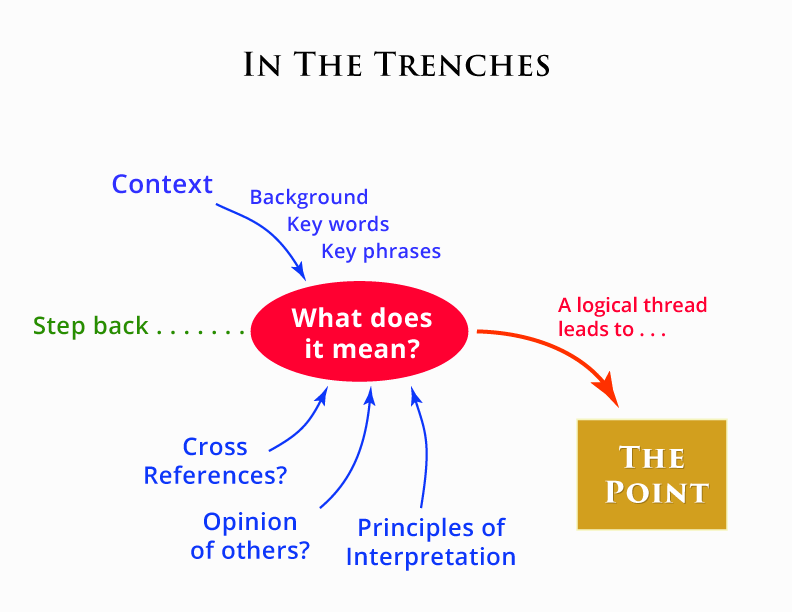
Bible Backgrounds
Our next group of Bible tools are Bible backgrounds. They are special books that provide information about customs and manners in the Bible.
Daily Devotion Books
Our final group is a list of recommended devotional books.
Conclusion
It is recommended that the reader visit the PowerPoint charts and see the books that are mentioned in this study. The icons of the books are from the year of 2021.
References:
1. J. Gray. Canaanites. Unger’s Dictionary. Moody Publishers. 1984. p. 202.
2. John MacArthur. “The Rich Man and Lazarus (2008 Resolved Conference)” Luke 16:19–31.
Suggested Links:
Recommended Devotional BooksHow To Study the Bible
Why Study the Bible? — benefits of studying the Bible
Why We Can Trust The Bible — inspiration and the canon of Scripture
Preparing to Study the Bible, part 1 — why so many interpretations?
Preparing to Study the Bible, part 2 — avoiding errors in interpretation
Preparing To Know What The Bible Says — best Bibles and more
What Does The Bible Say? — example of observing
Discovering the Meaning of Scripture — principles of interpretation
How to Apply the Meaning — principles to discover the application